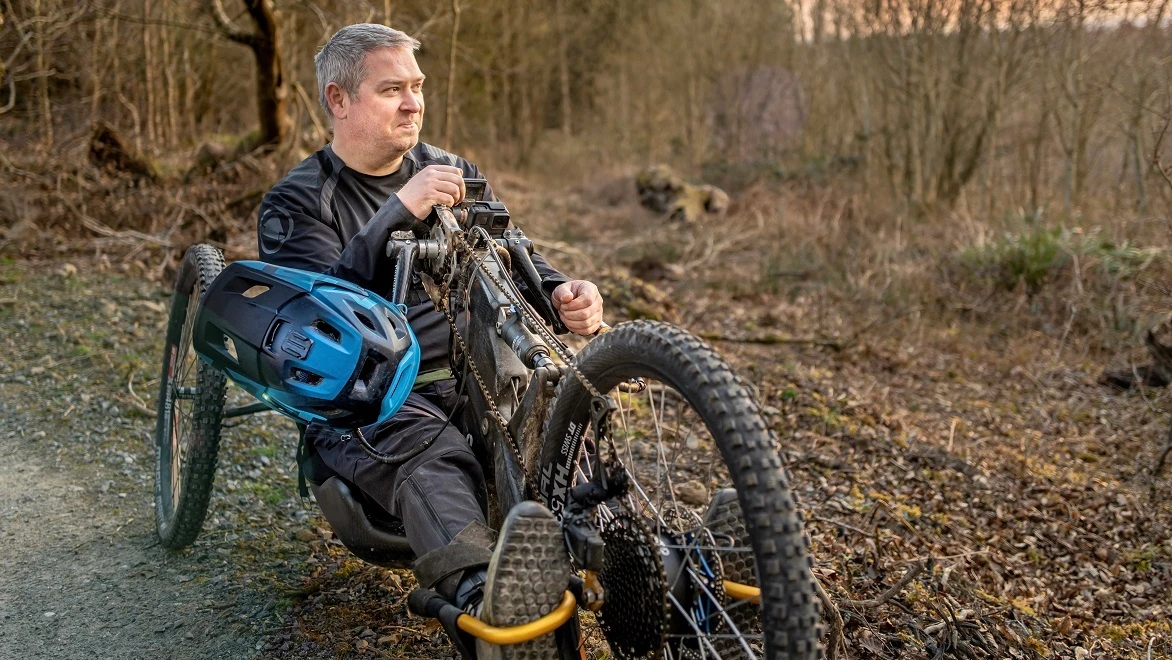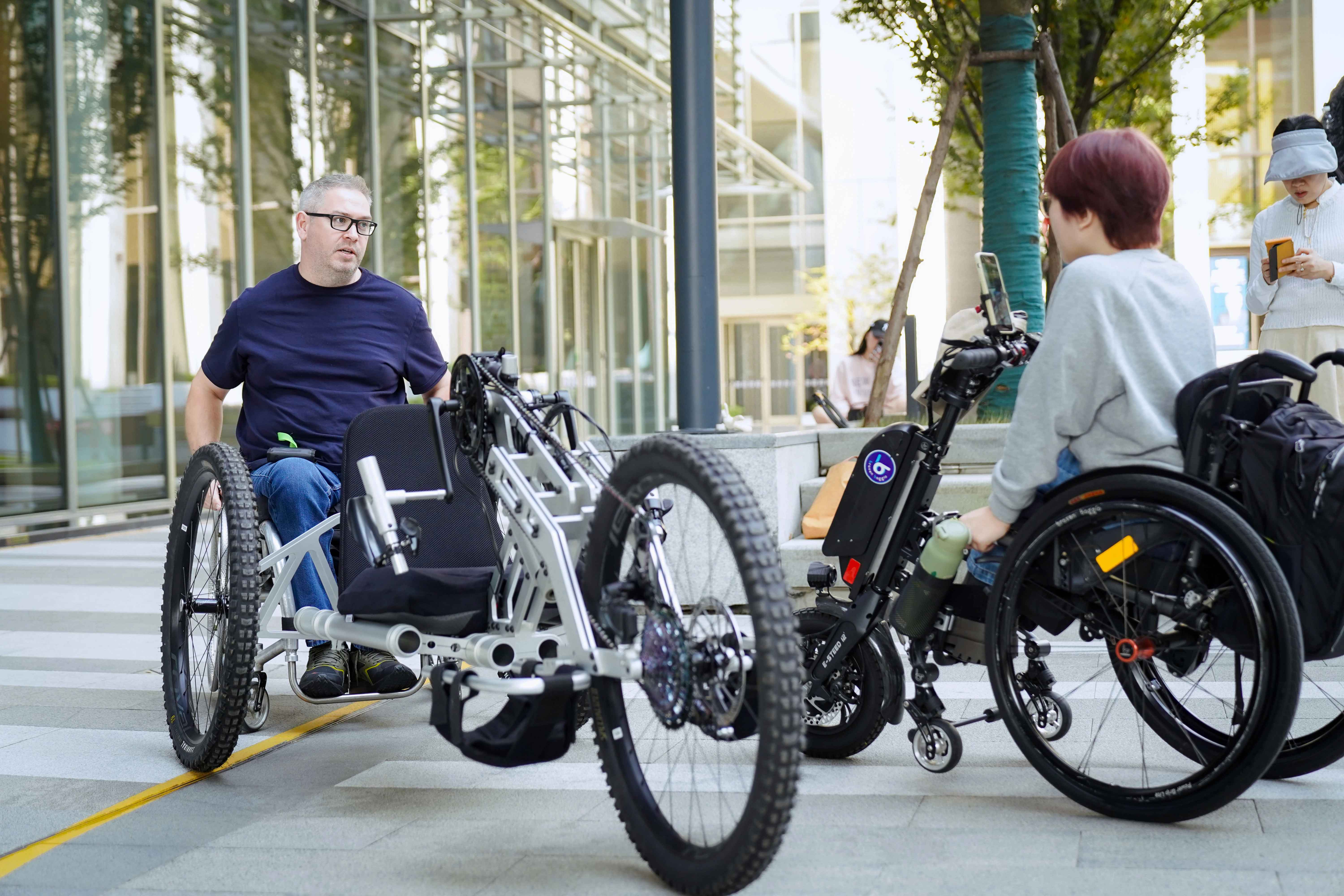& Construction

Integrated BIM tools, including Revit, AutoCAD, and Civil 3D
& Manufacturing

Professional CAD/CAM tools built on Inventor and AutoCAD
After experiencing a life-changing, mountain-biking accident that left Noel Joyce paralyzed from the chest down, he left his military career behind to pursue industrial design. Years later, he found his passion for biking again. But bikes for those with disabilities can be prohibitively expensive and difficult to repair. Joyce decided to change that by designing his own adaptive mountain bike with Autodesk Fusion. As a New York University professor, he brought students from campuses around the world along for the ride with Project Mjolnir.
As a child growing up in Ireland, Noel Joyce was obsessed with bicycles. For him, there was an incredible feeling of freedom when riding one. The mechanical side was also fascinating. He would often cobble together “Frankenstein bikes” from barely functioning parts in a quest to create a faster version.
Joyce even worked part-time at a bike shop during school and full-time once he graduated. A career in the military beckoned, and he joined the Irish Defense Forces. That didn’t stop his passion for biking. He continued to enjoy his rides and began to participate in adventure racing with his unit.
“But it was one day when I was out riding my mountain bike that life would change forever,” he says.
Riding out in the woods with adverse conditions, Joyce took a fall and broke his back, instantly leaving him paralyzed from the chest down.
“The pain was enormous, and I drifted in and out of consciousness a few times,” he says. “I couldn’t draw enough breath to shout for help. Luckily, my friend found me. After many hours, I got off the mountain and to the hospital.”
Joyce needed to learn how to live a “new normal” since he could no longer perform his duties as a soldier. It was during his months of rehabilitation that he began to explore other career opportunities. “I saw the difficulties for those with disabilities and wondered if I could do something to solve those problems,” he says.
At the age of 26, Joyce went back to school and studied industrial design at the Institute of Technology in Carlow in Ireland. At the end of his studies, he started a couple of small hardware-related startups. He then traveled to Shenzhen, China and worked at a hardware accelerator startup as head of design for eight years.
When COVID hit, Joyce’s career took another turn. He returned to Ireland and began teaching remotely for New York University (NYU) Shanghai. “Hosting my classes online, I was able to teach Fusion to students on the other side of the planet,” he says. “Two paths I was traveling at the same time were to converge in the near future, but not how I expected.”
During this time, he found himself literally getting back on the bike—albeit with three wheels instead of two. His first bike was very rigid and simple. One day, his neighbor saw him on it and suggested some trails in the nearby Slieve Bloom mountains.
“We set off on a Saturday morning,” Joyce says. “For the first time in 15 years, I rode down a mountain bike trail. It was terrifying and exhilarating at the same time. The adrenaline was fully flowing again, and the bug had well and truly bitten. I was back on the bike.”
It wasn't long before Joyce was outriding the bike's capability. There were frequent failures, leading to numerous repairs. It was clear that the bike was not going to last very long. Mountain bikes can be pricey, but adaptive mountain bikes are “frighteningly expensive,” Joyce says. There wasn’t much of a choice in his mind. He needed to design his own bike for wheelchair users.
-- Noel Joyce, Professor, New York University and Project Mjolnir
With Fusion, Joyce designed an entirely new type of adaptive mountain bike. Not only that, he set ambitious goals for the most complex, full-suspension bike possible. He spent hundreds of hours in Fusion, working out problems, creating specific geometry based on the desired characteristics, and figuring out how it would be assembled. Project Mjolnir was born. The name itself is inspired from both Thor’s hammer and the video game Halo.
“Giving the new bike a name seemed to solidify the direction,” Joyce says. “For Project Mjolnir there were a few core tenets I wanted to stick to in its development. It needed to be customizable, affordable, and repairable. I also wanted the ability for it to be built anywhere. And it had to be evolutionary—always able to change.”
Learning from past prototype failures, Joyce continued refining the design with the help of other NYU colleagues and outside vendors. In 2022, he traveled to New York to teach at NYU for a semester. While there, he was encouraged to apply for the VIP (vertically integrated projects) program at NYU Tandon School of Engineering. It includes multi-year, multidisciplinary projects for more than 1,000 students to get hands-on experience developing solutions to real-world problems. By using Fusion in this program, Project Mjolnir could move to the next level.
Throughout the entire design and development process, Fusion was central to landing a successful design. As Project Mjolnir grew, the benefits of Fusion and students’ ability to instantly access files in the cloud were undeniable. Now, the project was in full development with plans to assemble bikes at three major NYU campuses: New York City, Shanghai, and Abu Dhabi.
“We were able to give students access to the Fusion files before parts even arrived so they could use it like an instruction manual for the assembly,” Joyce says. “They could become really familiar with it before they even put their hands on metal to build these bikes. This expedited the speed at which we were able to assemble the bikes. We went from the first one taking us three days to two days for the second.”
Joyce, NYU staff, and the student teams set out a core objective to build four bikes at the three NYU campuses and in Ireland within the first year. They accomplished it in just under 10 months. They also hit another major milestone with the first adaptive mountain bike ride in New York City across the Brooklyn Bridge, followed by a ride on trails within the city not long after that.
With Fusion, the Project Mjolnir team is creating new modules for upgrades to the four bike examples already built. They are also releasing design files to the public for those wanting to build their own bike. According to Joyce, the hope is to build a community of riders, builders, and innovators and continue to develop the platform as an educational experience to learn about design and manufacturing.
“Project Mjolnir encompasses so many things,” Joyce says. “It's about education and evolution. And, most importantly, it's about inclusion. It's about taking something that was out of reach and making it accessible to more people. It is the pursuit of knowledge and development of empathy that will help students at NYU design and build for people in the future.”
Autodesk offers free educational access to Fusion software, learning content, and other resources.



